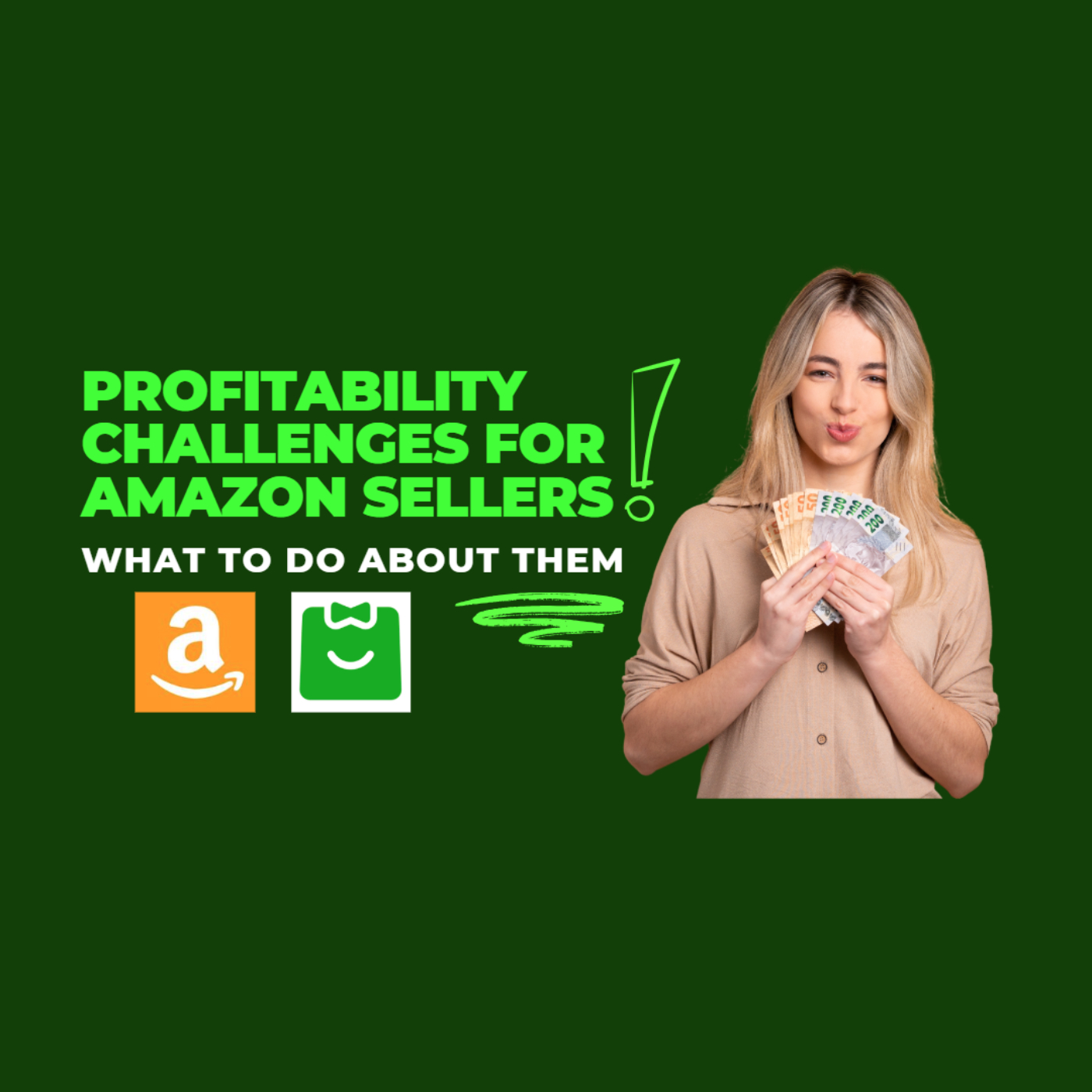- Order Management
- TikTok Shop
- Temu
- About 4Seller
- Amazon
- Shopify
- Inventory Management
- Amazon MCF&FBA
- Amazon Shipping
- UPS
- Seller Tips
- FedEx
- Listing Management
- DHL Express
- Creator Bulk Invite
- eBay
- GLS
- Marketplace News
- Shein
- Amazon MCF
- Walmart
- Royal Mail
- Multi-channel Store
- Inventory Sync
- Walmart WFS
- Poste Italiane
- Shipping Integration
- Yodel
- PayPal Tracking Sync
- Stripe Tracking Sync
- UniUni
- OTTO
- USPS
- 3PL
- WooCommerce
- Etsy
- Deutsche Post
- Correos Express
- Correos
- CIRRO
- DHL Parcel
- Chronopost
- CaiNiao
- Evri
- BRT
- Beginner Tutorial
- GOFO
- Kaufland
- Logistics Rule
- AliExpress
- Cdiscount
- OMS
- SPU Catalog
- DHL
- Shipping Label
- ShipHero
- ShipBob
- DPD
- Price Sync
- FBM
- Platform Integration
Profitability Challenges for Amazon Sellers and What To Do About Them
 By Joline05 Dec,2024
By Joline05 Dec,2024
If you sell on Amazon, you know the size and scale of the opportunity that the ecommerce giant provides. For many entrepreneurs and established ecommerce businesses alike, selling on Amazon is a vital part of growing a profitable business.
However, even though the opportunities are nearly endless, selling on Amazon has its challenges. High on the list is maintaining sustained, long-term profitability, given the millions of sellers competing for attention and market share. Sellers often encounter fees and surcharges they might not have expected, and there's constant price pressure as they strive to be seen as the most affordable option.
Through it all, businesses and brands must keep their eye on the prize: profit. To help address these profitability challenges, this guide will provide actionable solutions. One such solution is 4Seller, which enables sellers to automate order fulfillment across multiple platforms through Amazon FBA, thereby maximizing profits.
Are profitability challenges an issue for Amazon sellers at all levels?
The truth is, yes.
While it’s certainly possible to make money on Amazon, most ecommerce sellers on Amazon marketplace will encounter profitability challenges along the way. They affect sellers at all levels, including both new and well-established Amazon businesses.
The challenges do tend to change as a seller gains experience, though. New sellers face hurdles like managing startup costs and cash flow and achieving critical mass (which includes gathering customer reviews, finding and launching successful products, optimizing listings, and attaining initial, sustainable profitability).
Experienced sellers, on the other hand, face struggles related to scalability and profit margins. In addition to managing a growing market share, they have to account for PPC advertising costs, stay on top of sourcing, suppliers, and inventory, and develop a cohesive business brand.
What are Amazon FBA sellers?
Sellers who use Amazon’s Fulfillment by Amazon (FBA) program enjoy a high degree of convenience and less hands-on effort. They don’t have to worry about packaging, inventory storage, or the fulfillment side of the customer experience.
But premium fulfillment services like FBA come at a cost, leading some sellers to wonder whether selling through Amazon FBA is still worth it.
We say it certainly can be, but FBA sellers should be prepared for high fulfillment fees and storage costs. There’s also added complexity and costs for managing returns. Sellers in Amazon product categories like Clothing & Shoes, Jewelry, and Electronics may encounter greater profitability challenges due to the naturally higher return rates of these categories.
So, while FBA provides convenience, you’ll need to account for these added costs and manage them proactively.
What are Amazon FBM sellers?
The other option is Fulfillment by Merchant (FBM). This is the DIY approach, where the seller pays Amazon much less but bears the burden of shipping, handling, and inventory management.
FBM sellers retain greater control over their fulfillment processes, which can be both a blessing and a curse. They can inject a higher level of customer service and responsiveness, but they’re also on the hook for anything that goes wrong.
Taking the FBM approach can lower some costs, but maintaining profitability requires efficient, scalable processes.
Common profitability challenges for Amazon sellers
Let’s dig a little deeper into some of the most common profitability challenges for Amazon sellers of all sizes and types.
Amazon fees and unexpected costs
Even the most inexperienced seller can probably guess that selling on Amazon isn’t free. But exactly how, where, when, and how much Amazon takes can feel a little more mysterious. Here’s a quick breakdown of the fees Amazon charges third-party sellers:
- Referral fees: This is Amazon’s “cut” or commission — the percentage of your sales price that Amazon deducts from your seller account after the sale. These range from 8–45%, depending on the product category.
- Per-item or subscription fees: Professional sellers pay $39.99 per month to sell on the platform, while individuals pay $0.99 per transaction. Like referral fees, these are taken from your seller account, not upfront.
- Refund administration fees: Amazon-issued refunds cost you $5 or 20% of the refunded charge, whichever is less.
- FBA fulfillment fees: These are the fees FBA sellers pay for Amazon to handle fulfillment (including shipping). They range from $3.06 to $6.81 for most items up to three pounds.
- FBA storage fees: FBA sellers pay either monthly or long-term storage fees for items sitting in Amazon’s fulfillment centers. (These rates are quite complex — see our full guide to Amazon FBA fees for more details.)
- Other miscellaneous fees: FBA sellers may also incur low-level inventory fees and inbound placement service fees.
Thousands of sellers navigate these fees successfully and maintain profitability. But failing to account for these hidden and not-so-hidden costs can reduce or even destroy profitability.
Pricing pressure and competition
Pricing pressure is a common challenge across the entire retail industry. But it can be more pronounced on Amazon, where thousands of sellers with similar items could be competing for their slice of an astounding 2.7 billion monthly visitors. There’s often an immense pressure to offer lower prices, which could thin out your profit margins considerably.
Price wars are not unheard of, and then there’s the 50-million-pound elephant in the room: Amazon itself might jump into your product category with a good-enough Amazon Basics version, putting downward pressure on your prices.
Inventory management issues
Sellers who don’t maintain tight control of their inventory may incur extra fees or lose sales opportunities. FBA sellers must pay higher fees if they have too much or too little of a product in Amazon’s fulfillment centers.
In addition, overstocks tie up your assets in merchandise that isn’t going to sell anytime soon, and stockouts completely eliminate your ability to compete on the item you’re out of.
Customer complaints and returns
Customer behavior after the sale can hurt your profits, too. Unhappy customers may leave poor reviews, which hurt your search rankings, lower your conversion rates, and drag down profitability. Then you may have to invest more money to shore up whatever issue with your product(s) led to the complaints.
Returns are also a real concern. They cost you money and add to your administrative burden. Some returns are inevitable, but it’s a good idea to make adjustments to product listings where possible to reduce confusion and lower your return rates.
Ready to maximize your profit margins? See how 4Seller can help
To integrate TikTok Shop with Amazon Multi Channel Fulfillment (MCF) and automatically fulfill TikTok Shop orders using Amazon FBA inventory, please read on and follow the below step-by-step guide.
1. Create a 4Seller account
To integrate TikTok Shop with Amazon Multi Channel Fulfillment (MCF)/ FBA, you need to use a third-party app called 4Seller, which is free and trusted by many TikTok Shop and Amazon sellers. You can also search 4Seller ERP in your TikTok Shop Seller Center > Growth > App store.
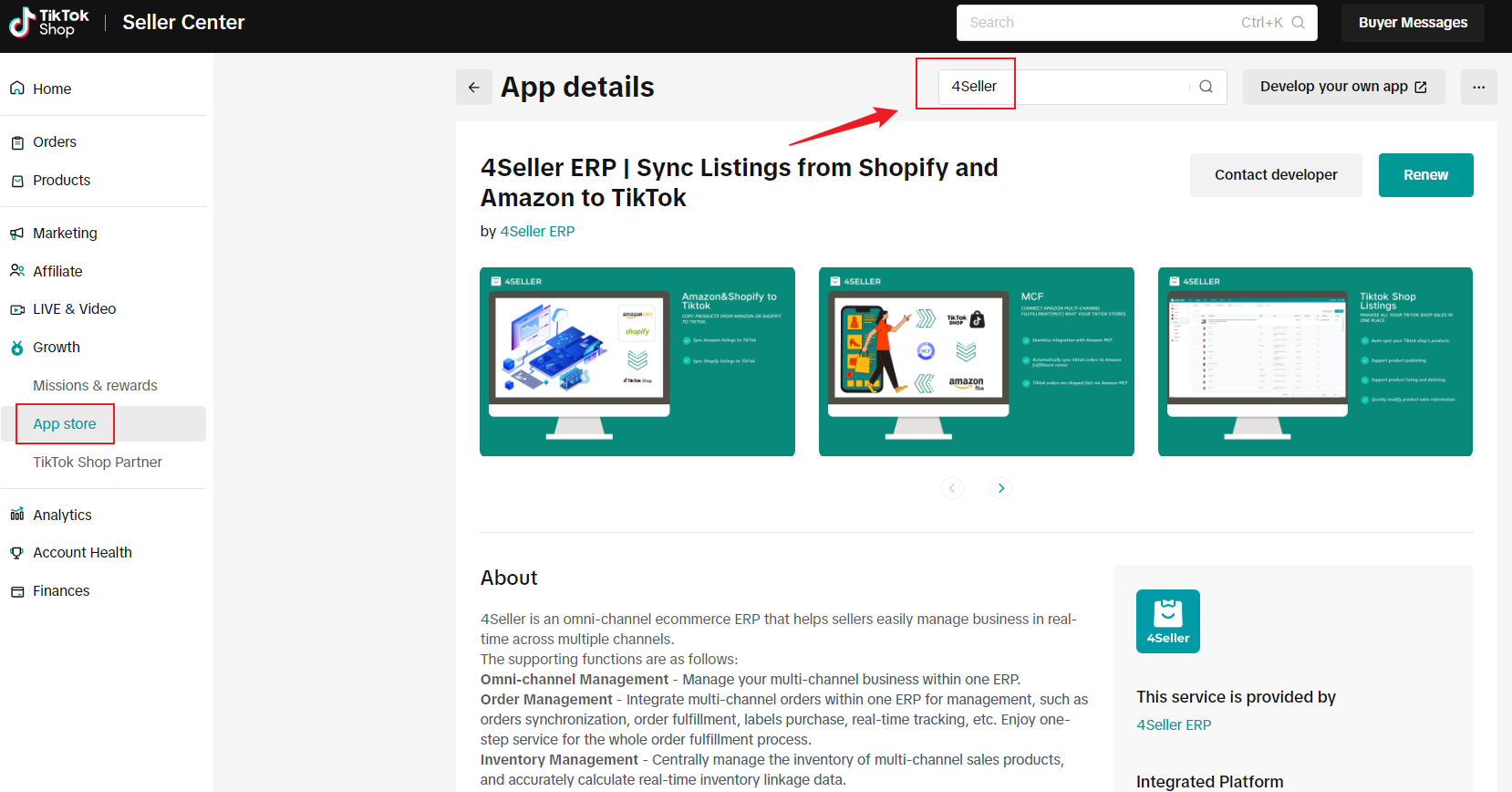
This integration has the potential to dramatically impact your digital presence, unlocking new growth opportunities and solidifying your brand image as a reliable and trustworthy retailer.
Open 4Seller website and sign up free for an account with your valid email address and a password.
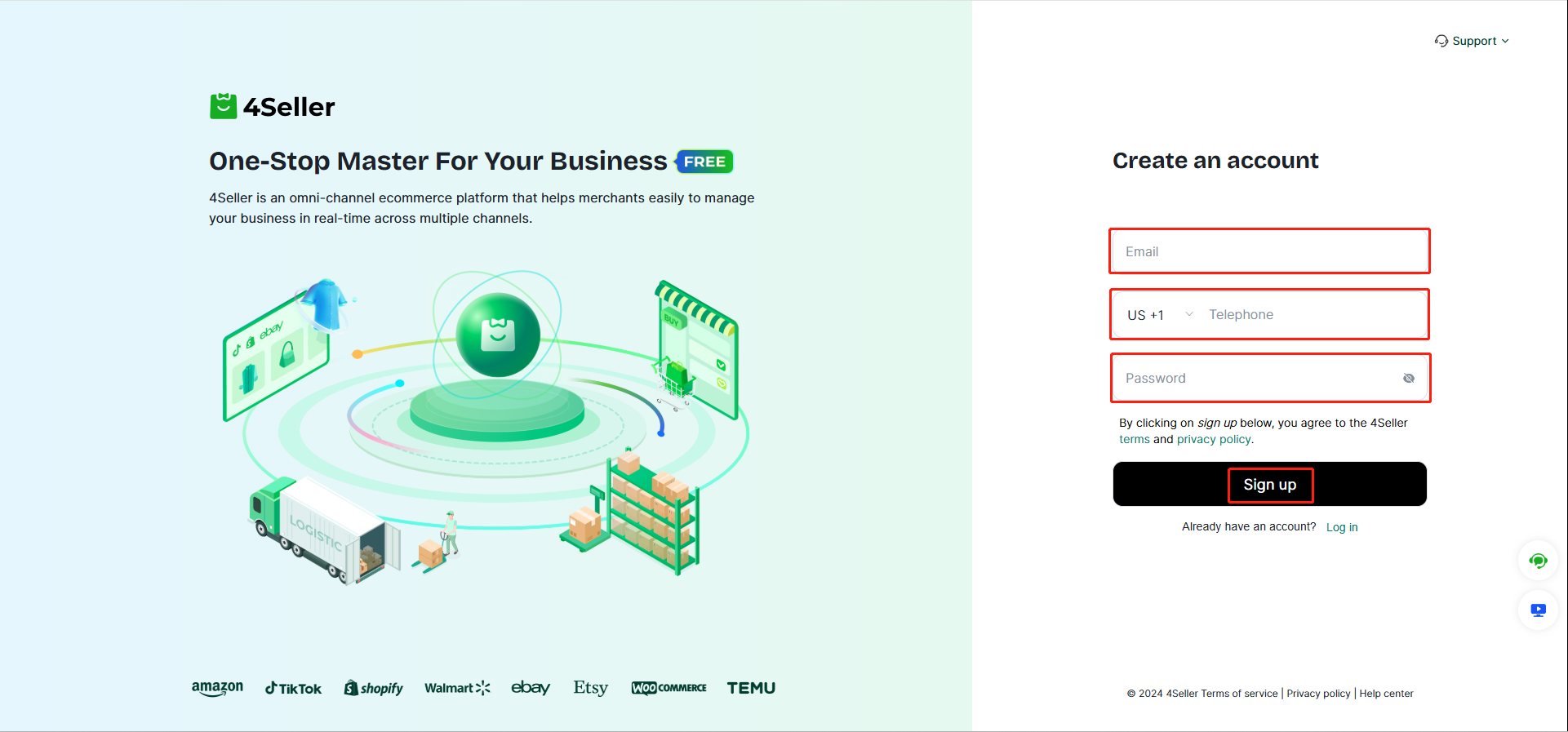
2. Connect TikTok Shop to 4Seller
Follow the 4Seller Setup Wizard on the Homepage, click TikTok Shop in the Sales Channel to link your TikTok Shop to the 4Seller system. Here is a complete guide on how to bind your TikTok Shop to 4Seller.
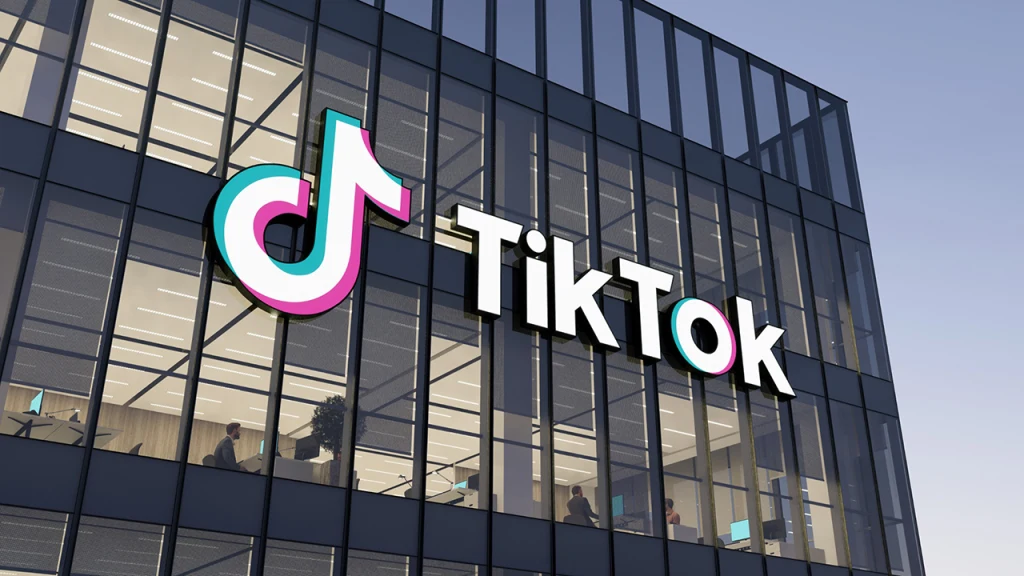
3. Link Amazon Seller Account to 4Seller
To use Amazon MCF to ship orders from TikTok Shop, you need to first connect your Amazon seller account to 4Seller. On the 4Seller's Shop Manage page, click the Amazon icon to connect your seller account to 4Seller.
4. Authorize Amazon FBA warehouse
Head over to Inventory Settings in 4Seller and click Create under the 3PF Warehouse section to add your FBA warehouse to 4Seller. After tapping the Confirm button, your Amazon FBA Warehouse will be authorized to 4Seller. This allows the 4Seller app to access your FBA inventory and fulfill multi-channel orders.
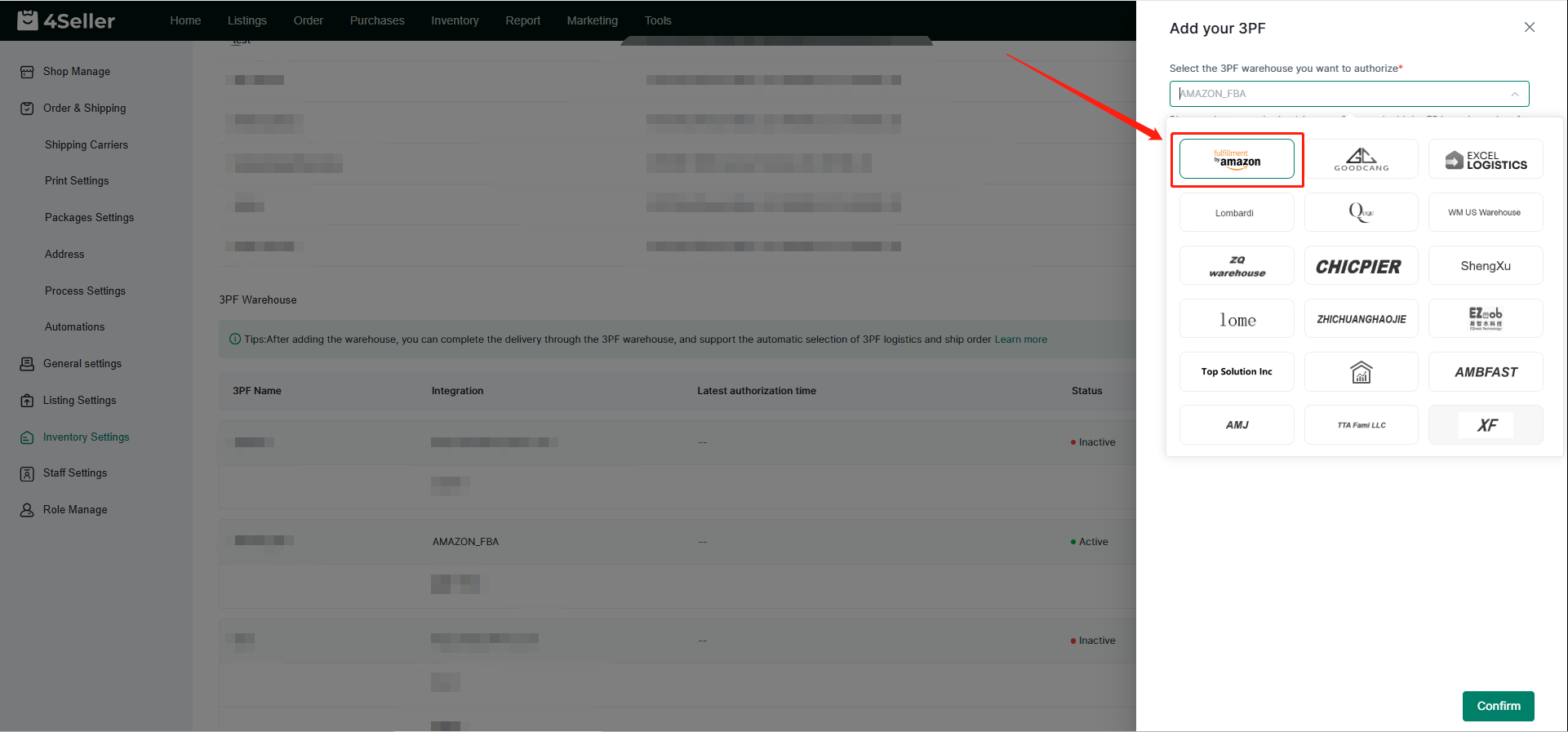
5. Sync FBA inventory and configure SKUs
To fulfill TikTok Shop orders with Amazon MCF, you need to sync the FBA inventory to 4Seller first. Go to Inventory > 3PF> Amazon FBA, click the Sync Inventory button in the upper right corner.
Ensure that the SKUS on 4Seller match exactly with the SKUs in your Amazon FBA inventory. Amazon uses SKUs to identify products for fulfillment, so mismatches can lead to fulfillment errors.

6. Automated Order Fulfillment via Amazon FBA with Logistic Rule
If you want to start making money on Amazon FBA, you can’t miss this one-stop tool-4Seller. Here are some of the key features that can significantly enhance your business:
By leveraging logistics rule, 4Seller ERP automates the entire order fulfillment process via Amazon FBA. Once orders are received from different platforms, the system automatically routes them for fulfillment through Amazon FBA, drastically reducing manual intervention and minimizing errors. Moreover, 4Seller ERP will automatically generate shipping labels and uploads tracking numbers back to the respective marketplaces after configuring logistics rules, ensuring timely and accurate order updates for customers. This automation not only accelerates delivery times but also enhances customer satisfaction.
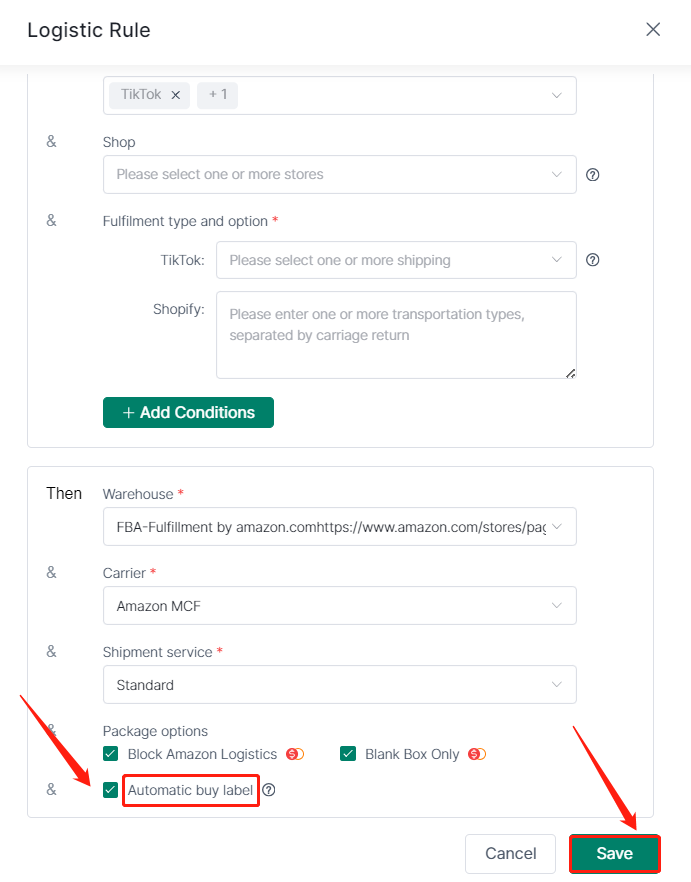
Below are the key functionalities of 4Seller ERP, detailed in points
1. Multi-Platform & Multi-Store Integration
4Seller ERP seamlessly integrates with various e-commerce platforms, enabling sellers to manage all their sales channels from a single, centralized dashboard. This includes Amazon, but also extends to eBay, Shopify, WooCommerce, and many more, allowing for a holistic view of sales performance and streamlined order fulfillment processes.

2. Real-Time Inventory Synchronization
4Seller ERP keeps your inventory levels up-to-date across all platforms, automatically adjusting based on sales and replenishment activities. This feature prevents overselling and ensures that customers are never disappointed by stockouts, maintaining a positive brand image.
3. Insightful Reporting & Analytics
The platform provides comprehensive reporting tools that offer deep insights into sales performance, inventory trends, customer behavior, and more. These actionable insights help sellers make data-driven decisions to optimize their strategies and maximize profits.
4. Scalability & Flexibility
As your Amazon FBA business grows, 4Seller ERP grows with you. Its scalable architecture supports the addition of new marketplaces, stores, and products without compromising performance. Furthermore, its customizable workflows allow you to tailor the platform to your unique business needs.
In conlusuion
Selling on Amazon presents immense opportunities for both entrepreneurs and established ecommerce businesses to grow a profitable venture. However, it also poses significant challenges, including intense competition, unexpected fees, and constant price pressure, which can impact long-term profitability. To address these challenges and maximize profits, Amazon sellers must remain focused on profit while leveraging solutions like 4Seller to automate order fulfillment across multiple platforms through Amazon FBA.
- Order Management
- TikTok Shop
- Temu
- About 4Seller
- Amazon
- Shopify
- Inventory Management
- Amazon MCF&FBA
- Amazon Shipping
- UPS
- Seller Tips
- FedEx
- Listing Management
- DHL Express
- Creator Bulk Invite
- eBay
- GLS
- Marketplace News
- Shein
- Amazon MCF
- Walmart
- Royal Mail
- Multi-channel Store
- Inventory Sync
- Walmart WFS
- Poste Italiane
- Shipping Integration
- Yodel
- PayPal Tracking Sync
- Stripe Tracking Sync
- UniUni
- OTTO
- USPS
- 3PL
- WooCommerce
- Etsy
- Deutsche Post
- Correos Express
- Correos
- CIRRO
- DHL Parcel
- Chronopost
- CaiNiao
- Evri
- BRT
- Beginner Tutorial
- GOFO
- Kaufland
- Logistics Rule
- AliExpress
- Cdiscount
- OMS
- SPU Catalog
- DHL
- Shipping Label
- ShipHero
- ShipBob
- DPD
- Price Sync
- FBM
- Platform Integration
- 17 Dec,2024
- 17 Dec,2024
